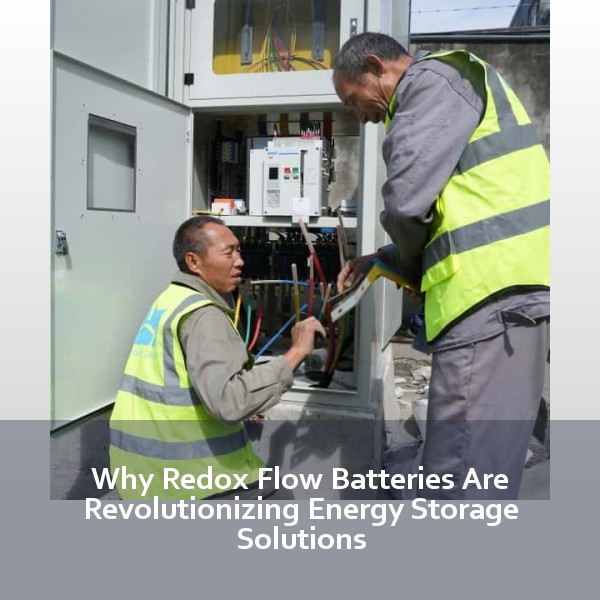Why Redox Flow Batteries Are Revolutionizing Energy Storage Solutions

Ever wondered how we'll store solar energy during monsoon seasons or keep wind power on tap when the breeze decides to take a coffee break? Enter redox flow batteries – the unsung heroes of renewable energy storage. Unlike their lithium-ion cousins that dominate your smartphone, these electrochemical marvels are built for the long haul, offering solutions that could make blackouts as rare as a polite Twitter debate.
How Redox Flow Batteries Work: The Science Made Simple
Imagine two giant tanks of liquid separated by a membrane – like rival football teams divided by a net. The magic happens when charged electrolytes (the players) pass through this membrane, creating electricity through redox (reduction-oxidation) reactions. The bigger the tanks, the more energy they can store – it's basically an electrochemical version of "go big or go home."
Key Components That Make It Tick:
- Electrolyte solutions (typically vanadium-based)
- Ion-exchange membrane
- Carbon composite electrodes
- Pump system for electrolyte circulation
Why Utilities Are Flocking to Flow Batteries
While lithium-ion batteries hog the spotlight, redox flow batteries are quietly stealing the show in grid-scale applications. Here's why:
- Endurance: Can provide 10+ hours of energy storage (Lithium-ion taps out at 4-6 hours)
- Longevity: 20-30 year lifespan vs. 8-15 years for lithium systems
- Shelf-life: Zero degradation when idle – perfect for emergency backup
- Safety: Non-flammable electrolytes reduce fire risks
California's recent 100MW/400MWh vanadium flow battery installation – enough to power 75,000 homes during peak hours – shows this isn't just lab talk. The project achieved 98.5% round-trip efficiency, making Tesla's Powerpacks look like energy sieves in comparison.
Real-World Applications Changing the Game
1. Renewable Energy Time-Shifting
Germany's 20MWh flow battery array stores excess wind energy at night, releasing it during daytime price peaks – like an energy arbitrage wizard making utilities millions while sipping schnapps.
2. Microgrid Marvels
In 2023, a remote Alaskan village replaced diesel generators with solar+flow battery systems. Result? Energy costs dropped 60% while achieving 99.98% reliability – crucial when -40°F temperatures make power outages life-threatening.
3. EV Charging Stations
Singapore's new fast-charging network uses flow batteries to avoid grid overload. The system can charge 30 EVs simultaneously without tripping circuits – a feat equivalent to running 10 hair dryers on a single bathroom outlet... but actually safe.
The Elephant in the Room: Challenges & Innovations
Let's not paint a utopian picture – current redox flow battery technology faces hurdles:
- Upfront costs 2-3× higher than lithium-ion
- Energy density comparable to lead-acid batteries
- Vanadium price volatility (jumped 300% from 2020-2022)
But innovators are tackling these head-on. China's Rongke Power developed a 200MW/800MWh system using recycled vanadium from steel slag. Meanwhile, MIT researchers created a pH-neutral organic flow battery that cuts costs by 60% – because who needs expensive metals when organic chemistry can do the job?
Future Trends: Where Flow Batteries Are Flowing Next
The redox flow battery market is projected to grow at 22.3% CAGR through 2030, driven by:
- New chemistries (iron-chromium, zinc-bromine)
- AI-driven electrolyte optimization
- 3D-printed stack components
- Government mandates like California's 6GW storage target
Japan's Sumitomo Electric recently demoed a "battery-as-a-service" model where customers lease electrolyte rather than buying systems outright – think Netflix for energy storage. Early adopters saw payback periods shrink from 10 years to 3.5 years.
Battery Showdown: Flow vs. Lithium-ion
It's not a winner-takes-all battle. While lithium dominates portable devices and EVs, flow batteries excel in stationary storage. Imagine lithium-ion as sprinters – great for quick bursts – while flow batteries are marathon runners, pacing themselves for the long haul.
A 2023 Stanford study found hybrid systems using both technologies reduced grid storage costs by 34% compared to either technology alone. The future's bright for this electrochemical tag team.
Pro Tip for Energy Nerds:
Next time someone mentions "energy density" as lithium-ion's trump card, hit them with this – flow batteries scale capacity independently from power. Want more storage? Just add electrolyte tanks. It's like upgrading your beer fridge without needing a bigger kitchen.
As we transition to renewables, redox flow batteries for energy storage are proving to be more than just a backup plan – they're becoming the backbone of resilient power grids. With major players like Lockheed Martin and Dalian Rongke investing billions, the question isn't "if" but "when" these liquid-based systems will flow into mainstream adoption.
- Pre: Harnessing the Breeze: How Wind Power Energy Storage is Revolutionizing Renewable Energy
- Next: Solar Thermal Energy Storage Systems: Engineering Breakthroughs and Practical Applications
Related Contents

PowerCube VFlowTech: Revolutionizing Energy Storage with Vanadium Redox Flow Batteries
Ever tried powering your smartphone with a potato battery? That's essentially what we're doing with conventional energy storage systems in 2025. Enter PowerCube VFlowTech, the vanadium redox flow battery that's turning heads from Singapore's Jurong Island to Silicon Valley boardrooms. Unlike traditional lithium-ion batteries that lose steam faster than a deflating balloon, this technology offers scalable energy storage that could finally make renewable energy reliable 24/7.

Vanadium Redox Flow Energy Storage: The Future of Grid-Scale Battery Solutions
lithium-ion gets all the glory in energy storage conversations. But there's a dark horse in the race that's been quietly powering entire cities: vanadium redox flow energy storage (VRFB). Imagine a battery that doesn't degrade over time, can scale up to power a small town, and uses the same element in both electrolyte tanks. That's VRFB technology in a nutshell.

Redox Flow Batteries: The Unsung Heroes of Renewable Energy Storage
It’s 2025, and California just hit 100% renewable energy for 30 straight days. But here’s the twist – the real MVP wasn’t the shiny solar farms, but the redox flow batteries humming quietly in substations. These liquid-based storage systems are rewriting the rules of renewable energy storage, and they’re doing it with the elegance of a ballet dancer holding a car battery.
